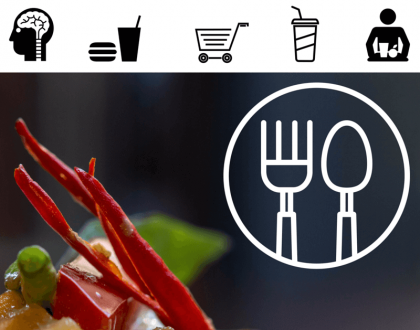SEO Restaurants: How To Get Your Restaurant On Page 1 Of Google

by Joe Sainz
Everyone wants to be number 1 in Google but getting to that position can be very challenging and time consuming. Depending on how new your website is, it’s existing
1. Is your website holding you back?
The program or algorithm that Google uses to asses where your website should rank is based on a number of different factors and ignoring any one of them could be holding your business back. One factor as described by Google is “Site Speed” which refers to how quickly your website loads. As Google’s main aim is to provide users with search results which are helpful and extremely relevant, a slow site speed is an indication that a visitor will have a bad user experience on your website, causing Google to penalise you.

If you’re wondering what your site speed is both on desktop and mobile, Google offers a free online tool to check the speed of your website. This tool analyses your website page speed and will give it a score out of 100 for mobile and desktop. Along with your score, Google will also provide a list of points which you should consider fixing. One of the most common reasons for your website to get a low speed score is images which are too big causing the file size to slow down the loading time of your website. This is one of the simplest fixes for your website as there are a number of resources available for free, online which enable you to reduce the file size without compromising the image quality.
Often Google will return some recommendations which you may need a ‘more technical’ person to implement such as the recommendation to Minify JavaScript or reduce server response time. For things like this it often makes sense to hire a developer to make small updates and maintenance. Although it will cost you in the short term, the benefits will be much longer lasting for your website and ultimately your business.
2. Do content the right way
Even if you’re new to the world of restaurant SEO you have probably heard the phrase ‘content is king’. This is especially true after the Google Panda update which penalises low quality content and rewards unique user focused content on your website. This means that producing relevant and useful content for your website that is not duplicated from elsewhere on the web, will help you rank well in Google.
Before you start creating content for your website, use Google’s Keyword Planner to research the best keywords for your website. It will often be tempting for you to pick the most generic keyword with the highest volume of search traffic, but the reality is that these keywords are also the most competitive and take a long time to rank for. Additionally, the way users search in Google is constantly evolving and people are increasingly typing in more specific search terms (or as they’re known the in the SEO industry “long tail keywords”). Choosing to include these long tail keywords in your content will not only mean that you are more likely to rank on page 1 of Google in a shorter amount of time but it will also send extremely relevant visitors to your site who were looking for the exact content that you have written.
Content is a broad term which encompasses a lot of different types of media, from blogs to infographics, YouTube videos. Deciding which type of content is right for your business is key, then making sure that it is original, useful to your target audience and optimised for the most relevant keywords.
Consideration should be given to which keyword is picked for which page as you don’t want two pages of your website to be competing against each other for rankings in Google. Make sure that you use different keywords for different pages choosing keywords based on their relevance in the context of the content of the page and website structure.
For a simple page of content or a blog post, the most important place to include the target keyword is in the H1 and again in the main body copy or include a variation of this keyword in the main copy. Overuse of the same keyword again and again is considered ‘spammy’ by Google and will not result in long term success. It is best practice to also include internal links in the content of your copy to other relevant pages on your website. Google notices that by linking internally you are helping the visitor find the information that is most relevant to them rather than ‘trapping’ them on a page with no links to other pages.
3. Make sure your meta data is right
Once you have done some keyword research and decided which page of your website you want to optimise for which keyword, you not only need to include this keyword in the content of that page but also in the meta data and page title.
Not only does this serve as a call to action to click-through on to your site rather than your competitors, but it is also crawled by Google and considered to be a very important ranking factor. If you have existing keyword rankings then it is important to consider carefully any changes to your meta data or page title as these could result in a loss of the rankings you already have.
The closer to the beginning of the meta description or page title the more importance it is considered to have by Google. Page titles should be between 50 – 60 characters and the meta description should be between 150 – 160 characters. If you don’t write a meta description and page title, you are missing a very good opportunity to help your website climb up the rankings.
4. Don’t ignore external ranking factors
Once you have ensured that your website is as fast as it can be, you have selected your relevant keywords and applied them to the meta data and unique content of your website, you have won half the battle. In addition to these ranking factors which are determined on your website, Google also has a number of offsite ranking factors. You need to have a variety of relevant links from other website’s back to yours in order for Google to rank you well and recognise your website’s authority. For this reason it is best to get external links from website’s which themselves have a high authority. Open Site Explorer is a free online tool which tells you the authority score of the website you input and is very useful for linkbuilding.
Since the Google Penguin update it is clearer than ever that the volume of links is nowhere near as important as the value of links you are obtaining. Careful and thoughtful link placement is the best approach, using a cocktail of relevant 3rd party websites like forums, directories and blogs or content sites to include links which make sense in their location, using a mixture of keywords. Using the same keyword over and over again in the same location will likely result in penalisation by Google as it recognises this as a spam link building tactic.
Another offsite factor which can benefit your website’s ranking in search results are what’s known as “Social Signals” these social signals are indicators such as sharing of your content i.e. linking back to your website and also factors such as ‘likes’ or ‘tweets’. For this reason having a healthy social media presence where you are interacting with others and sharing your content can only help you rank better.
Recommended Posts

SEO For Restaurants and Good Reviews: What You Need To Know
December 18, 2016

Content Marketing For Restaurants: Why It’s So Valuable
December 18, 2016

Restaurant Menu Psychology: What You Need To Know
December 18, 2016
